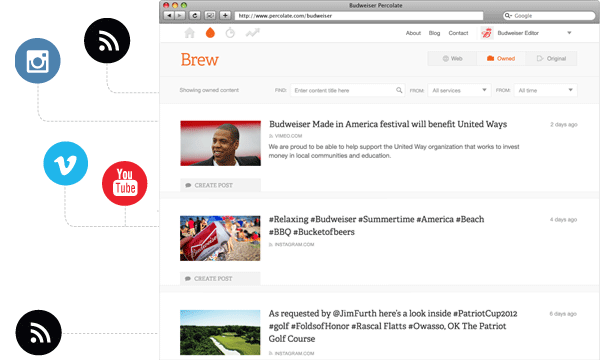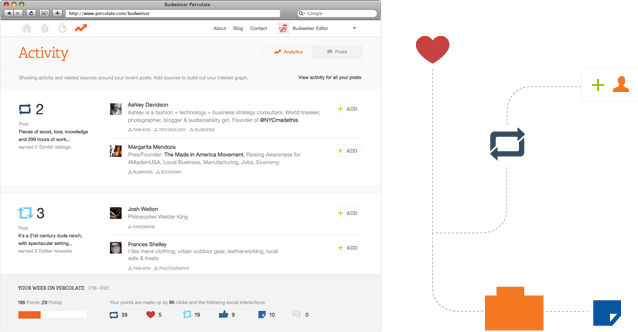Social Media Management
Brew Up Great Content at Social Scale with Percolate

Percolate has only been around since January 2011, but they’ve already started to revolutionize the way businesses use social media for a healthy list of big brands. The New York-based company is growing quickly and spreading the word about its mission to create content “at social scale.” We talked to co-founder James Gross about the origins of the company and about how Percolate is changing the way companies consume ideas, create content and build brand identities through social media.
![]()
WEBSITE: www.percolate.com
FOUNDED: 2011
LOCATION: New York, NY
CUSTOMERS: MasterCard, Samsung, Reuters, IBM, Nokia
Why did you start Percolate?
My co-founder Noah Brier and I started Percolate with the idea that we’re going to actually attack disruptions in the marketplace from the technology perspective, and we’re going to try to help brands systematize how they think about creating content. Then ideally, as we learn over time, we can help them create more effective content, and then the ideal promise of social is to learn from the swaths of data on these social platforms that consumers interact with brands when they’re consuming their content. Brands learn from all these many lightweight interactions that they now have with consumers, and that can inform everything that a brand does. Your flow content is starting to inform your stock content, so that brands can make more content in real time and in aggregate based on the little pieces of data that they’re creating – little pieces of media that they’re creating for these massive audiences that they never reached before.
How did you get interested in social content?
Our goal in starting the company was to address a couple of interesting things that we were seeing just from the overall market. I came from a company called Federate Media Publishing. I ran the publishing products division of that company the last 2.5 years I was there. My goal as an employee of that company was to help brands become publishers. The most successful platform that I built was something called American Express Open Forum, which is now one of the top five small business sites on the internet.
The interesting thing about social to me is how brands are acquiring audiences in social. If you think about being a publisher, you think about how to build an audience traditionally. You have three basic costs. You have the cost of acquisition of an audience, a cost to distribute to that audience, and a cost of content creation. What was happening with social was incredibly disruptive to the idea that brands were going to acquire audiences and be able to distribute to those audiences on social platforms. They were taking care of the first two costs of the three costs in publishing. What I was seeing was this idea that brands were going to have massive, massive audiences on social. What they needed was a better way to actually create content at scale. Stock content is the type of content that brands create in partnership with agencies, where they look at trends and glean insights from that. Then often they create these big, beautiful, timeless assets. Generally assets are pieces of media that are based on very slow-moving trends because they take a long time to create, and they’re expected to stay in market for a long time. To give you an example, the average TV commercial takes about 18 to 22 weeks to create, costs anywhere between $3 and $5 million and stays in the market for anywhere between three and nine months’ time. That’s in the stock world. The stock world works very well, but the challenge is that brands are moving into flow, where they’ve acquired massive, massive amounts of audiences in all these platforms.

Their challenge is they need to create content in real time. To go back to how you think brands create stock content – in the world of flow, your Tweet doesn’t matter nine minutes later, let alone nine months later. So this huge paradigm shift that’s taking place right now for brands is the need to better systematize how they think about creating content , so they can go from creating three to four television commercials a year to 30-40 pieces of content per day on platforms like Facebook and Twitter and Tumblr and Pinterest and Instagram and LinkedIn and G+. All these platforms revolve around the basic premise that as a brand you acquire an audience, and then you systematically create content for them on a continual basis. There’s no such thing of traditional advertising on these channels. You’re expected to be a content creator.
Within the marketing environment that you just described, what is your approach and process?
In terms of market size and marketplace, we exclusively work with very large enterprise companies. I think of us as the Fortune 500 or Fortune 1000 provider. Inside these larger companies you have what’s called the set brands. So inside of P&G there are about 57 addressable brands. We work with those individual sub-brands, and we also scale based on market. One of the other interesting phenomena happening now is brands need content on local levels. You need to be relevant on Facebook or Twitter or Tumblr in the local languages in various countries. So we can scale to all the markets within these companies as well with our software.
How does Percolate work? Take us through the process of using your platform.
The first thing we do with the brand is we sit down and go through what we call the calibration process. The goal of the calibration process is basically to help a brand consume content in order to create it. One of the big insights in starting Percolate was this idea that why brands struggle in flow, or why they struggle in social, is because they don’t consume anything. Brands have never traditionally had to consume anything. They’ve created content, but in a stock way where agencies dictated culture and created timeless assets. In real-time social, the behavior that’s happening among consumers is that people like you and me are constantly consuming content – via our passions and interest graphs. If you look what I follow on Twitter and then you looked at what I tweet, it would reflect that I consume things like entrepreneurship, technology, surfing, and running. That’s what I’m interested in, and that’s primarily with I consume and talk about. Brands struggle to do this because they’ve never had to do it before. And brands of course don’t have interest graphs because they’re not people. But brands do stand for things, and they have ideals. During the calibration process we want to break that down into a set of sources – really things on the internet that create content with the idea that we’re going to pull all this into Percolate. This is what’s going to help make the brand culturally relevant in real-time to help them create content.
What we can do is take these few answers from the brand, then we have a database of about 6 million sources at Percolate that we have mapped out across different categories. We help build out a much larger and more refined interest graph for the brand. Then we pull into Percolate and create your “Brew.” What we’re doing is looking at what are your sources linking to, and we’re scoring each link and the relative influence of each link based on who that source is, and then we’re trying to bubble up the most interesting content. The goal of this is to help the brand basically stay on top of what’s interesting across these key focus areas for them and constantly bundle up new and fresh content. Additionally the brand has what’s called a DAM, or digital asset management library. We want to get into that and basically suck up all of the assets that the brand owns that we can actually index. The goal of that is to constantly help the brand live at this intersection between what’s culturally relevant and what the brand stands for. That’s what branding has always been about, but the challenge is they’ve never had to do that in real time. So the goal of course is to have them live at this intersection in real time across what’s happening in the world they care they about with what they might already own that could be resurfaced based on what’s interesting and what’s happening.

What happens once I’ve picked an article that I’m interested in, and want to push it out?
We’ll recommend media. If you’re going to create a piece of content, whether it’s on Facebook or at your dot.com, you generally have a piece of media to accompany any text you’re going to create. What we do is we recommend images. How we recommend images is we’re actually scraping that article for keywords and we’re taking those keyword tags and paying a couple of different APIs to pull back photos that are either free of copyright. We also ping our Getty Images partnership and license that we have set up that gets access to $5 royalty-free photos. Then we also ping a brand DAM looking for relevant old photos. Unlike humans, where basic copyright infringement happens all the time on social platforms, a brand can potentially be sued for copyright infringement. So we have to protect the brand while helping them of course create content at the scale they needed. The editor knows they can trust Percolate to only return photos that they can use.
The final step in the process is something called a hunt post. It basically allows you to reroute your traffic from Facebook or Twitter. Instead of linking off to the third-party article, you actually link back to your dot.com, where you might have written more content. This creates an ecosystem where the brand is able to leverage their social channels with these massive audiences to drive people back to their dot.com, where they own the whole brand experience and there’s another opportunity to get another branded impression.
How else does Percolate help users stay on top of content creation?
Another big, big part of the future of Percolate is communication outside of the standard platform. One part of this is email. We think of email as an incredibly effective way to keep a conversation going for the people that use our software. One thing we send out is the Daily Brew email. That goes out with your top five stories from the day before. That goes out at 7 a.m., so you’re starting the morning with the editor to inspire you. We also have an email called Spark. When a story is very popular, and it’s reached a threshold that you set within Percolate and it automatically sends you an email to say “Two or more of your sources are talking about this story. You most likely want to check it out.” The third email is the win email. This will notify you if any of posts exceeds a certain threshold of engagement. You can see how it performed across all these different channels – Tumbler, Facebook, Twitter, as well as your dot.com. This feedback also informs the algorithm. We train the algorithm on whether this was a good post or a bad post. It then funnels the importance of each story back down into the sources that bundled it up. The algorithm is trying to help you continually refine and build out your interest graph.
We also have a weekly email that shows you how are you doing against all the different goals that you set up in the system. We’ll recommend articles worth taking a second look that passed through your interest graph over the past week. You didn’t create any content around them, but these seem like really interesting stories that you generally create content around. The other thing we’re doing is recommending sources to you that we think are important to what you’re doing. And then finally, the last thing that we’re doing in this weekly email is we’re prompting you with a brief . Basically what we’re telling you is – hey, we’ve created something new that we think you’re really interested in. The premise of the brief is that we want to start to learn long-term what we think is working and why, and really drive insights from a technology perspective to say “over the past six weeks or three months, these types of stories have been trending through your interest graph.” We’ll give you some stories that you might be inspired by, along with some stories that you’ve already created content around that performed well. What we want you to be able to do with the brief is give it to an agency, and allow them to basically create a larger piece of content around. So you’re allowing all your little pieces of content to inform your bigger pieces of content. Maybe you invest in an infographic or a longer form blog post, or even go so far as to say this could inform how your next TV commercial. We help a brand build a sustainable, always-on content strategy that helps them live at this intersection of what’s relevant and what their brands stands for – trying to help the brand be as effective as possible with their content, basically helping them build out the ideal mix of content that’s going to help them sell their products. Then we just want to be more efficient. We think a lot of the work that’s being done right now in social can be rooted in technology that to date has been a very humanized workflow of how content is created for these massive brands in social.

Content editors must absolutely love this. It takes the legwork out of content curation- you don’t have to spend your whole mornings searching for sources.
Exactly. You nailed it. The big thing about writers as it relates to brand writers, is generally you’re talking about a much more junior person – and of course a person that isn’t necessarily a journalist. Yet they’re writing to audiences in the millions. Think about Oreos as just an example. It has 32 million fans on Facebook. It’s increasingly becoming about additional platforms, like Tumblr, Pinterest, and Instagram. So they really need help, and they really need technology to help them.
You talked about how the marketing environment has changed from that long cycle, where you’re investing money and resources into creating commercials. Companies have a junior writer doing social media, but they wouldn’t put a junior writer in charge of creating a commercial that’s going to run for six months.
That’s exactly right. This is the crazy stuff that just happens as disruptive technology changes things. This is what social has done. Social has put the power of the entire brand in people – if you think about it, it seems silly that there’s a 22-year-old running your account right now that reaches 20 million people, but that’s what happens because they know Facebook the best. So they sort of get put in charge. Of course, brands are starting to realize, “Actually, we reach more people in social than anywhere else on the planet, including even selling our own products. There are more touch points in social.” The other important part of that recognition is social is owned by the CMO, because social is traditionally a marketing communications channel. But as social continues to disrupt, people are saying the future of business is social – like IBM’s new tagline. The idea is that social is this disruptive force that’s going to be the future of how big brands do business. With that in mind, what’s interesting about that is the CMO finds themselves in this position where they need to buy technology. They sit on this data that maybe traditionally the CTO or CIO sat on. Of course, we’re leaning into that market shift, which is CMO as purchaser of technology. We’re very excited about it, and it’s something that CMOs definitely need. Basically they’re saying, “Whoa! We can reach more people on Facebook than we can with a Super Bowl commercial, and yet we spend $50 million on what’s called non-working and working media on a Super Bowl commercial between how you produced it and how you much you run it in market. We basically pay someone – we pay 22-year-olds- to create all their content in Facebook. I think CEOs are rapidly trying to figure it out.
Are you guys alone in this segment? Or is there anybody else trying to do what you’re already doing?
We’re definitely alone in the content segment. Our goal as a social software company is to really laser focus on that mission, which is how brands create content in social scale. Clearly there are things that help brands create content, but it’s not software. I think that’s why we’ve been able to get the success we’ve had; we have 33 Fortune 500 brands now. We’re a profitable company. We’re looking to continually grow even as a young company. This is a very complex topic that we’re dealing with. It’s not just technology. Clearly technology is a very important component. But you actually have to understand how brands work and how brands operationally have created content in the past, there’s a lot of social software that focus on traditional listening, where they listen to brand mentions or listen to keywords. There’s a lot of technology in the management space of social software -Buddy Media, Buffer, Wildfire, SproutSocial. They’re all very similar technology. And not to talk disparagingly, but from a technology perspective they’re similar, and then you differentiate yourself based on your ability to sell accounts. To actually go after content requires a much deeper understanding of how brands work. I think that’s why we’ve been able to get so far ahead with no real competition in the marketplace.
What challenges do you see at this point?
It’s going very well. We want to expand the company significantly, and we’re going to get that done. With any software company, it’s about adoption; then it’s about penetration inside these larger accounts – getting more and more brands to sign up. We’re incredibly excited about the progress, but we have a very large dream of helping brands do this. We have a very expansive expectations of how people in large companies are going to create content on behalf of their brand. We have a very long way to go to realize the entire vision, but so far, we’re excited.
Looking forward, what is the most exciting thing happening with Percolate right now?
It seems like there’s a lot. I think one of the things is the culture that we’re building. We have an incredibly strong product team, with the client successes as well as with the amount of penetration we’ve had. We’ve only had a sellable product for a year now. We have an incredibly strong business team, too. I think when you have a culture of having an incredibly strong product team and an incredibly strong business team, very big software companies can be created out of it.
Looking for more information on social media management? Check out our side-by-side comparison of leading platforms in the Top 10 Social Media Management Software report. You can also browse exclusive Business-Software.com resources on social media management by visiting the social tools research center.





